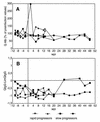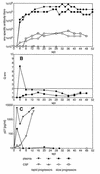Protective role of the virus-specific immune response for development of severe neurologic signs in simian immunodeficiency virus-infected macaques
- PMID: 9811731
- PMCID: PMC110507
- DOI: 10.1128/JVI.72.12.9940-9947.1998
Protective role of the virus-specific immune response for development of severe neurologic signs in simian immunodeficiency virus-infected macaques
Abstract
The pathogenesis of human immunodeficiency virus-associated motor and cognitive disorders is poorly understood. In this context both a protective and a harmful role of the immune system has been discussed. This question was addressed in the present study by correlating the occurrence of neurologic disease in simian immunodeficiency virus (SIV)-infected macaques with disease progression and the humoral and cellular intrathecal antiviral immune response. Overt neurologic signs consisting of ataxia and apathy were observed at a much higher frequency in rapid progressor animals (6 of 12) than in slow progressors (1 of 7). Whereas slow progressors mounted a strong antiviral antibody (Ab) response as evidenced by enzyme-linked immunosorbent and immunospot assays, neither virus-specific Ab titers nor Ab-secreting cells could be found in the cerebrospinal fluid (CSF) or brain parenchyma of rapid progressors. Similarly, increased infiltration of CD8(+) T cells and cytotoxic T lymphocytes specific for viral antigens were detected only in the CSF of slow progressors. The finding that neurologic signs develop frequently in SIV-infected macaques in the absence of an antiviral immune response demonstrates that the immune system does not contribute to the development of motor disorders in these animals. Moreover, the lower incidence of neurologic symptoms in slow progressors with a strong intrathecal immune response suggests a protective role of the virus-specific immunity in immunodeficiency virus-induced central nervous system disease.
Figures






References
-
- Amadori A, De-Rossi A, Gallo P, Tavolato B, Chieco-Bianchi L. Cerebrospinal fluid lymphocytes from HIV-infected patients synthesize HIV-specific antibody in vitro. J Neuroimmunol. 1988;18:181–186. - PubMed
-
- Baskin G, Murphey-Corb M, Roberts E, Didier P, Martin L. Correlates of SIV encephalitis in rhesus monkeys. J Med Primatol. 1992;21:59–63. - PubMed
-
- Bohm R, Martin L, Davison-Fairburn B, Baskin G, Murphey-Corb M. Neonatal disease induced by SIV infection of the rhesus monkey (Macaca mulatta) AIDS Res Hum Retroviruses. 1993;9:1131–1137. - PubMed
-
- Brey R, Arroyo R, Boswell R. Cerebrospinal fluid anti-cardiolipin antibodies in patients with HIV-1 infection. J Acquired Immune Defic Syndr. 1991;4:435–441. - PubMed
-
- Coe C, Reyes T, Pauza D, Reinhard J. Quinolinic acid and lymphocyte subsets in the intrathecal compartment as biomarkers of SIV infection and simian AIDS. AIDS Res Hum Retroviruses. 1997;13:891–897. - PubMed
Publication types
MeSH terms
Substances
LinkOut - more resources
Full Text Sources
Research Materials

